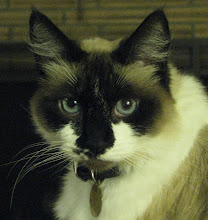
I spent most of the weekend at the Oregon College of Arts & Crafts, immersed up to my elbows in Judilee Fitzhugh's workshop on one-pot natural dyeing. "One-pot" means that the entire process -- cooking up the dyestuff (usually plant material), mordanting, and dyeing -- happens in the same pot. It's easier and less messy, in some ways, than Procion (tm) dyeing, and generally less toxic, though it takes more prep and the results are less predictable. The leaves, stems and flowers of the same plant might all yield different colors; time of year and water source figure in as well.
A mordant, for those of you who haven't been hanging out around the dyepots, is a substance that helps bind the dye to the fabric (though not all dyestuffs require the extra help). Simply

using an aluminum, copper or iron pot will often provide enough mordant to do the job. We used powdered alum, as well as a copper vat and a nicely-rusting iron pot. Different mordants skew the results toward darker or brighter shades; iron, for instance, "saddens" or grays the color. (This process goes back to medieval times, and some of the terminology, wonderfully, does, too.)
An amazing array of vegetable matter will yield worthwhile dyes. Queen Anne's lace, dahlias, daffodils, rhododendrons, manzanita and madrone are all good dyestuffs. There are dozens of books on the subject; I picked up a lot of information (some of it contradictory) browsing

through Judilee's collection. You can dye with turmeric, saffron or annatto -- which has been moldering in my spice collection for years -- rhubarb leaves, which are poisonous when ingested, red cabbage, spinach or chard, and of course coffee grounds or old, cold tea. Hey, throw it in your dye vat before you put it in your compost bin!
For the workshop, though, we used three colorific crowd-pleasers that come pulverized and pre-packaged: osage orange, logwood and brazilwood. They tend toward yellow, purple and red, respectively. We also stewed up some walnut hulls (brown) and a mess' o' Japanese knotweed (red-brown). I even brought in some of those hateful spiky seedballs from my sweetgum trees, hoping to find some redeeming value in them. Nah.

Judilee mixed up some freeze-dried indigo, by popular request, just to have on hand. The proximity of a vat of indigo, ready to go, is very alluring, and I ended up with more blue fabric than I'd intended. We also used the indigo to overdye some of our yellows to a lovely green. Ironically, despite the grass-stained clothing of our childhood, not many dye plants yield a good clear green.
There were only three of us in the workshop, me and two women named Amy, which made it easy for Judilee; she already knew me, so everyone else had to be Amy. A class this small gave us all room to experiment, ask questions and compare results, and made it so much less of a hassle to find space to work and to hang dripping pieces of fabric. And it was quiet. It felt luxurious. On Friday in particular, when it rained hard all day, it was lovely to stand over a steaming dye vat, thinking that I had
nothing to do at that particular moment other than what I was already doing.

Anyway, we dyed a variety of silks, from organza to dupioni (yum), plus some wool that I'd bought at Mill Ends and shared around (that's the wool hanging to dry in my laundry room at home). I dyed the rest of the cream-colored, rose-patterned damask tablecloth that I used last year in my
Mom Quilt. One of the Amys brought in hemp, which took the dye well, too. By the end of the class, each of us had an enviable stash of fabrics in a range of gorgeous, lush colors, as well as some yarn and thread that we'd wound and dipped, plus a few skeins that Judilee had prepared for us.

Weeks ago, when I registered for the workshop, I couldn't see myself stewing up vatfuls of miscellaneous stalks and stems on my own stovetop, but I figured that this would be a good opportunity to find out what natural dyes were all about. The workshop not only met my expectations, it fired my imagination. I am my mother's Saran-Wrap-washing daughter, after all, and the idea of using stuff that's free for the picking, pruning or scavenging is very appealing. Plus there's the hippie granola Berkeley/Portland sustainability thing -- reduce, re-use, recycle -- which has been part of my psyche, if not always my practice, ever since I can remember. So I came home yesterday and ordered two natural dyeing books. Now I'm eyeing my rhododendrons.
















